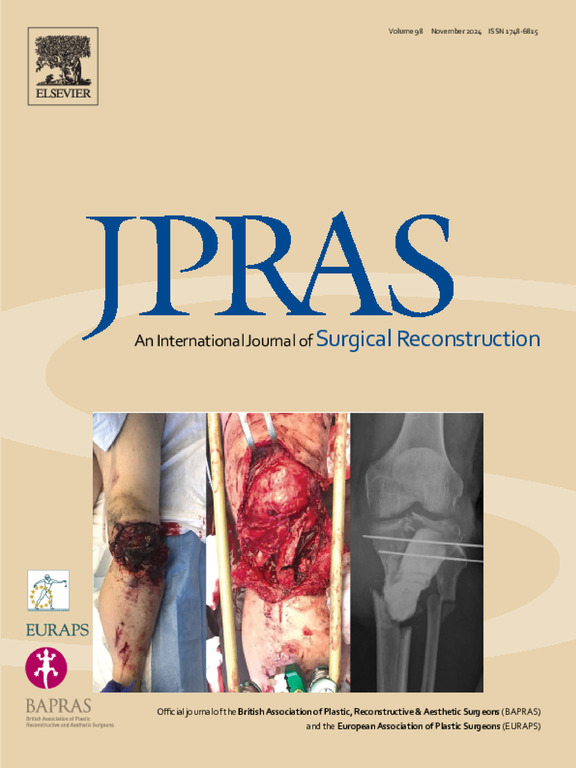节省数百万:在整形和重建手术中改用无水手术洗手液的经济影响
IF 2.4
3区 医学
Q2 SURGERY
Journal of Plastic Reconstructive and Aesthetic Surgery
Pub Date : 2025-06-30
DOI:10.1016/j.bjps.2025.06.027
引用次数: 0
摘要
基于酒精的手术洗手液是一种安全、环保且具有成本效益的传统水性洗手液替代品,得到了世界卫生组织(WHO)的支持。这些优点使含酒精的洗手液成为各种整形和重建手术的理想选择。本研究评估了在整形和重建外科部门过渡到酒精基手术磨砂膏的潜在财务节省。方法数据收集于同一医院整形重建外科。根据世卫组织指南测量了传统手术洗手液的用水量。水费是根据波士顿供水和下水道委员会的费率计算的。酒精溶液和浸渍刷的费用从医院的围手术期服务中获得。使用年度手术量数据来估计用水量和消耗品成本。根据世卫组织方案计算节省的时间并将其转化为节省的费用。结果平均每次擦洗用水量为7.62 L,平均每次手术用水量为36.17 L。如果每个整形手术都使用传统的湿式擦洗器,每年的用水量将为87,233.76升,每次擦洗的水成本为0.05美元。每次清洁的耗材成本,酒精类清洁为0.20美元,湿性清洁为0.52美元。每年,过渡到含酒精的磨砂膏将节省3090.96美元的消耗品成本。采用无水擦洗和减少擦洗时间可为我们部门每年节省$1316,445.48。结论在整形和重建手术中过渡到含酒精的外科洗手液可提供显著的环境和经济效益。本文章由计算机程序翻译,如有差异,请以英文原文为准。
Saving millions: The economic impact of switching to waterless surgical hand scrubs in plastic and reconstructive surgery
Background
Alcohol-based surgical hand scrubs are a safe, environmentally friendly, and cost-effective alternative to traditional water-based hand antisepsis, supported by the World Health Organization (WHO). These advantages make alcohol-based hand scrubs ideal for various plastic and reconstructive surgery settings. This study evaluates the potential financial savings of transitioning to alcohol-based surgical scrubs within a division of plastic and reconstructive surgery.
Methods
Data was collected from a division of plastic and reconstructive surgery at a single institution. Water consumption for traditional surgical hand scrub was measured according to WHO guidelines. Water costs were calculated based on the Boston Water and Sewer Commission rates. The costs of alcohol solution and impregnated brushes were obtained from the hospital’s perioperative services. Annual surgical volume data were used to estimate water consumption and consumable costs. Time savings were calculated based on WHO protocols and converted into cost savings.
Results
The average water consumption per scrub was 7.62 L, with an average of 36.17 L used per surgery. If every plastic surgery procedure used traditional wet scrubs, the annual water consumption would be 87,233.76 L. The cost of water per scrub was $0.05. The consumable cost per scrub was $0.20 for alcohol-based scrubs and $0.52 for wet scrubs. Annually, transitioning to alcohol-based scrubs would save $3090.96 in consumable costs. Adopting waterless scrubs and decreasing scrub time could result in savings of $1316,445.48 annually in our division.
Conclusion
Transitioning to alcohol-based surgical hand scrub in plastic and reconstructive surgery may provide significant environmental and economic benefits.
求助全文
通过发布文献求助,成功后即可免费获取论文全文。
去求助
来源期刊
CiteScore
3.10
自引率
11.10%
发文量
578
审稿时长
3.5 months
期刊介绍:
JPRAS An International Journal of Surgical Reconstruction is one of the world''s leading international journals, covering all the reconstructive and aesthetic aspects of plastic surgery.
The journal presents the latest surgical procedures with audit and outcome studies of new and established techniques in plastic surgery including: cleft lip and palate and other heads and neck surgery, hand surgery, lower limb trauma, burns, skin cancer, breast surgery and aesthetic surgery.

 求助内容:
求助内容: 应助结果提醒方式:
应助结果提醒方式:


